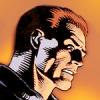Thompson Folktale Motif Index
Today I made the lucky discovery that one of the university libraries near me actually has a CIRCULATING copy of the 1932 Thompson Folktale Motif Index. I promptly checked out all 6 volumes and am exploring them. While it's clear that there are a lot of cultures' mythology that weren't recorded, translated, and available for indexing in 1932, I think the fascinating thing is the index system itself, which is based on patterns observed in a large mass of myths from several cultures. Although the author did not do so, it would be quite possible to present an index like this as a morphology of the mythological systems comparable to Propp's Morphology of the (hero-monomyth type) Folktale. See the "31 Functions" listed here if you aren't familiar with Propp's recipe for a hero monomyth.
For example, the first section of the index focuses on origin myths. It could be morphologized like this:
1. In the beginning existed primeval [chaos, darkness, or water].
2. Either a god/pair of gods existed alone in this undifferentiated environment, or a society of gods and/or monsters existed in a celestial or cthonic world.
3. There is an initial difficulty with creating the world - an argument over how to do it, an ingredient which must be retrieved from a dangerous place, or a lack of knowledge of how to do it properly. Optionally, the flawed first world is destroyed and must be remade better.
4. After being created, the world's inhabitants are clueless, do not have clear divisions into different types, and the world tends to be missing important elements. However the creator(s) work is done and they pass out of the story. Often the end of the creation period in some way foreshadows the end of the world and associated myths.
5. After the initial imperfect creation is a golden age of culture heroes, demigods, and tricksters. Two main types of stories exist in parallel: the reproduction/fighting/test story, and the theft/magic/fame story. Both of these exist in straight and inverted formats: unregulated reproduction causes fighting which is solved by the creation of divisions/barriers; reproduction is blocked by barriers which must be overcome by fighting, such that successful fighting is rewarded with reproduction; an inherently magic person undergoes some personal disaster but steals something to the benefit of his whole culture; a person wrongly wants something and his attempts to acquire it cause temporary magical disaster for his culture. Monsters and their destruction tend to occur primarily in this type of myth.
6. Many myths explain the origin of a particular object, custom, or characteristic/behavior of the natural world; similarly, some characterize a particular deity/nation/race and their function. Myths featuring animals and plants primarily belong in these two categories.
7. After everything has been created and the golden age has become the historical world, myths focus mainly on interactions between people and attempt to describe human nature and warn of dangers within a society. These are the stories about class, wealth, greed, jealousy, marriage, primogeniture, authority, fools, tricky wording, personal advancement, defying traditions, murderers, alcohol. In some ways these are more refined and narrowly-focused versions of the myths in 5; most fairytales would fit into this category. One primary difference between these myths and earlier ones is that characters begin to have personalities rather than just being their roles.
8. Finally there are end of the world myths, which attempt to give closure in the future to what origin myths have circumscribed the beginnings of in the past. End of the world myths also have a moral dimension describing how what happens after death rewards or punishes people for their behavior in the current day, and connects the people of the current day with their ancestors, historical and culture heroes, and deities.
That's just a vague outline, the actual index goes into more interesting subcategorizations and may have some major categories that I didn't notice yet. But overall I think it would be really interesting to put together some sort of workbook a writer could use as an aid in creating an original myth system. [smile]
I want to help design a "sandpark" MMO. Optional interactive story with quests and deeply characterized NPCs, plus sandbox elements like player-craftable housing and lots of other crafting. If you are starting a design of this type, please PM me. I also love pet-breeding games.
The Stith Thompson Motifs are also available online. (www.talesunlimited.com).
Looks like it's designed for educational users, so may be of interest to students here.
Sean Timarco Baggaley (Est. 1971.)Warning: May contain bollocks.
That's an interesting site. I'm puzzled by the fact that you can request a free trial but they don't have any prices for actually subscribing, as far as I can tell.
I want to help design a "sandpark" MMO. Optional interactive story with quests and deeply characterized NPCs, plus sandbox elements like player-craftable housing and lots of other crafting. If you are starting a design of this type, please PM me. I also love pet-breeding games.
This topic is closed to new replies.
Advertisement
Popular Topics
Advertisement
Recommended Tutorials
Advertisement







